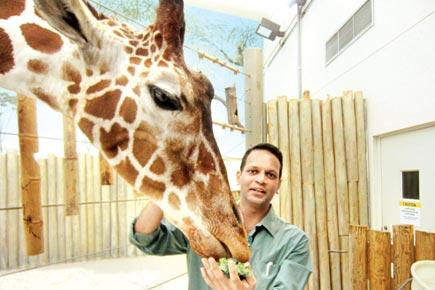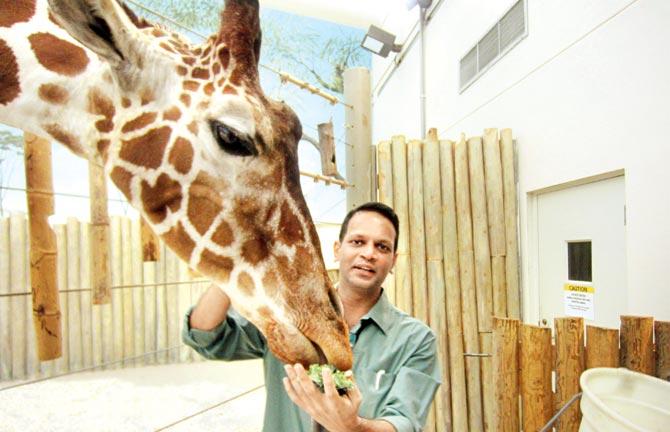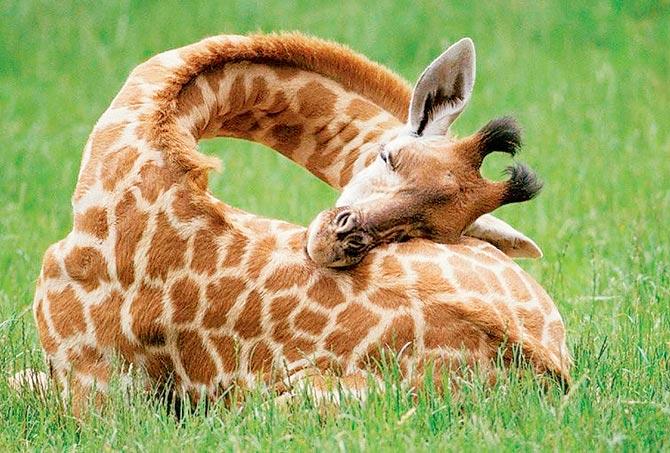A Thane-based researcher hopes to conserve the giraffe population which has dropped by 40 per cent in 15 years

Tushar Kulkarni at the Brookfield Zoo in Chicago last month where he presented a paper on giraffes
 For the tallest animals on earth, giraffes are awfully gentle," says Tushar Kulkarni, a researcher in the field of wildlife and conservation. The majestic herbivores with ochered flagstone fur are not anal about their territory, have no pack leader and have a more-the-merrier-attitude, i.e. they are very comfortable with a giraffe from another herd joining them. "They are fascinating. Every giraffe has a different set of patterns in its skin, just like a fingerprint," he says.
For the tallest animals on earth, giraffes are awfully gentle," says Tushar Kulkarni, a researcher in the field of wildlife and conservation. The majestic herbivores with ochered flagstone fur are not anal about their territory, have no pack leader and have a more-the-merrier-attitude, i.e. they are very comfortable with a giraffe from another herd joining them. "They are fascinating. Every giraffe has a different set of patterns in its skin, just like a fingerprint," he says.

Tushar Kulkarni at the Brookfield Zoo in Chicago last month where he presented a paper on giraffes
ADVERTISEMENT
For the last six years, the Thane resident has been studying the behaviour of giraffes in order to devise appropriate conservation methods. Kulkarni first became interested in giraffes in 2010, while interning for Bombay Natural History Society, where he was assisting in the conservation and outreach programmes for students.
"At that point of time, I came across the work of Dr. Julian Fennessy, Conservation Scientist and Co-Director & Co-Founder of Giraffe Conservation Foundation (GCF) who has been working tirelessly to conserve the giraffe species because he feels if we don't do it now, we might lose them forever." While reading material available online, what startled Kulkarni was the dearth of information available on giraffes. "It was amazing that something as well known as the giraffe could be so little studied. That stimulated my interest," says Kulkarni, whose day job involves working for a manufacturing unit in Bhandup.

The life of giraffe is approximately 25 years in the wild
A part of Kulkarni's interest in these stately animals has to do with the alarming fact that in the past 15 years, the giraffe population in the world has plummeted by nearly 40 per cent from 1,40,000 to less than 80,000. Statistics released this year by the Central Zoo Authority of India, show that there are a total of 27 giraffes in our zoos.
Giraffes, which are currently classified as a single species with up to nine subspecies, are found throughout sub-Saharan Africa. "While the life of a giraffe is 25 years in the wild, they tend to live longer in captivity [about 30 years] if kept well," he explains.
Last September, Kulkarni spent a week at the Kolkata Zoo, built in 1876 and also India's oldest, studying the behaviour of giraffes. "Out of the seven giraffes in the enclosure, I studied the behaviour patterns of the two males, a female and a calf." Typically, males spend about 22 per cent of the 24 hours in a day walking, compared to females who walk for 13 per cent of the day. "However, giraffes in Indian zoos barely get to walk around because the enclosures are approximately 400 square metres, while the zoos abroad have an area of about 2,000 square metres or even bigger."
When unable to walk, giraffes develop abnormal behavioural traits such as licking the walls in an enclosure, pacing and head-bobbing or circling. "Giraffes need to constantly ruminate or re-chew the cud to function normally," he explains. Typically, the diet in captivity consists mostly of food concentrates, which are consumed rapidly and do not provide stimulation for their long tongues. "The only way to keep the animal engaged is by using enrichment devices like hay racks, browse balls and automated feeders that would delay their feeding time. If you offer them food on a tray, they will wipe it clean in 5 minutes, but if you use these devices, they are kept engaged," says Kulkarni, who presented a paper on his research conducted at the Kolkata zoo at the International Giraffe Conference held last month in Chicago.
When at zoos, Kulkarni feels it's important to be quiet when around the animal. Noise tends to disturb them, which is why the zoo forbids people from playing music or throwing food inside their enclosure. Enclosure design, he feels, has an impact on behaviour. "I have suggested a larger enclosure so that they have space to roam. You may notice giraffes lying down quite a bit in captivity, but they don't do it as often in the wild as it is time consuming for them to get to their feet, which make them vulnerable to predators.
Also, the stereotype licking behaviours occurring in captivity are not seen in free-ranging giraffes But, here they are bored." Kulkarni feels the key solution is to extend foraging time. "You even get toys that can be hung from a height, so that the giraffe can rub its neck against it or bang his head. They can be quite the headbangers," he laughs.
 Subscribe today by clicking the link and stay updated with the latest news!" Click here!
Subscribe today by clicking the link and stay updated with the latest news!" Click here!







